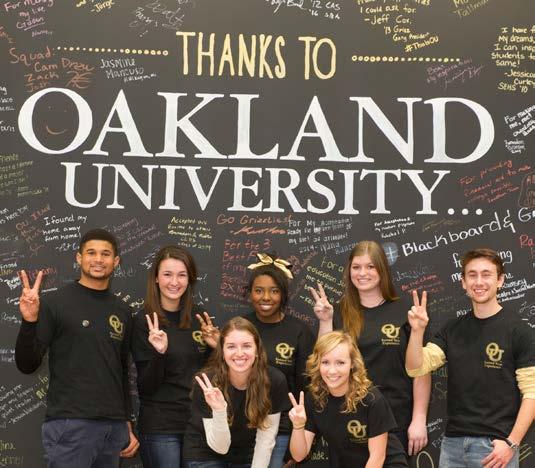eSource for College Transitions, Vol. 17 No. 2 March 2020
Second and Transfer Year Experience: Remembering the Forgotten Middle Children “Since SYE’s implementation in fall 2013, the number of second-year students on track to begin their third year has increased from 71.2% to 77.6%.” Hannah Braun, Student Experience Graduate Assistant, Oakland University Krista Malley, Director of Student Success, Oakland University Juretta Bailey-Grajewski, Student Success Coordinator, Oakland University The story goes that middle children tend to feel left out or excluded, but with the introduction of the Second Year Experience (SYE) and the Transfer Year Experience (TYE) programs at Oakland University (OU), in Rochester, Michigan, the middle children (i.e., the second-year and transfer students) no longer need to fight for attention. Housed in the Office of Student Success (OSS), the SYE and TYE programs were created to support students who (a) are transitioning from their first year to their second year or (b) who have transferred from another university. OU is home to approximately 19,000 students each year, and 2,285 of those were second- or transfer-year students in the 2018-2019 academic year. The SYE program began in 2013 after winning the 2012 OU Grand Idea contest, which invites academic professionals to submit to the office of the president their ideas for new or improved practices, programs, or facilities. The concept was submitted by a group of academic advising directors and academic advisors who knew that students are most likely to transfer during their second year (Hossler et al., 2012). The goal of the SYE program is “to facilitate student involvement and continued academic success in secondyear students as they progress through their degree programs.” The need to also support transfer students through their first year at OU was recognized in 2016, and TYE was established “to facilitate student involvement and continued academic success in transition year for first-time transfer students as they progress through their degree programs.” Students who are classified as First Time in Any College (FTIAC) have completed their first year, met with their First Year Advising Center academic advisor, completed at least 28 credits, and enrolled in SYE for their second year. Students who are new to OU with less than 56 credits are enrolled in TYE. The enrollment process is automatic, but the program is voluntary, and no holds are placed on accounts if students do not participate. These initiatives help hundreds of the program’s students each year feel more connected and engaged on campus while reinforcing the larger mission of OSS “to promote campus-wide initiatives for all OU students with an emphasis on academic engagement that encourages student persistence to graduation.”
Areas of Engagement According to Williams and Manning (2014), academic advisors must “utilize an individualistic approach to advising that facilitates selfand career-exploration, while encouraging student engagement in the academic community” (para. 2). These programs were designed around five areas of engagement: major/minor exploration, research engagement, career engagement, campus/community engagement, and wellness engagement. The five areas are defined as:
• Major/minor exploration, which helps students discover ways to browse majors and minors available at OU. Students can spend time weighing their likes, dislikes, strengths, and weaknesses to determine their future major/minor. • Research engagement, which gives students an opportunity to explore ways to participate in academic research. Talking to experts about research can expose students to different research needs and allow them to evaluate their own research interests. • Career engagement, which shows students the necessary steps to choose a career. Using career service amenities, students can browse potential employers, career-related events, internships, and open positions for which they can immediately apply. Students are also able to review their résumé and cover letter, manage personal social media branding, or prepare for interviews and career fairs. • Campus/community engagement, which gives students an opportunity to use the OU GrizzOrgs service to browse hundreds of clubs and organizations and to also encourage students to get involved on campus. Students work with the Office of Student Involvement’s Volunteer, Involvement, and Partnership program where students log volunteer hours for service recognition and the opportunity to be acknowledged for giving back to the community. • Wellness engagement, which encourages students to identify what wellness means to them. Complimentary wellness coaching is available by appointment, and the Oakland Counseling Center can help students through issues like anxiety or depression. SYE includes all five areas of engagement; however, TYE does not address major/minor engagement because transfer students typically have an idea for their major/minor.
Program Description With the goal of encouraging students to be involved with the engagement areas and to ensure they are staying on track with their major and persisting to graduation, OSS (a) encourages participants in these programs to meet with their academic adviser once in the fall (August-December) and again in the winter (January-April), (b) sends monthly e-newsletters to participants, (c) hosts several SYE/TYE engagement events throughout the academic year, (d) hosts weekly informational tables throughout campus, and (e) collaborates regularly with campus partners, so students know about the events and opportunities taking place. Meeting with academic advisors helps students determine if they are still in the best major/minor for them and to talk about the SYE
page 8




